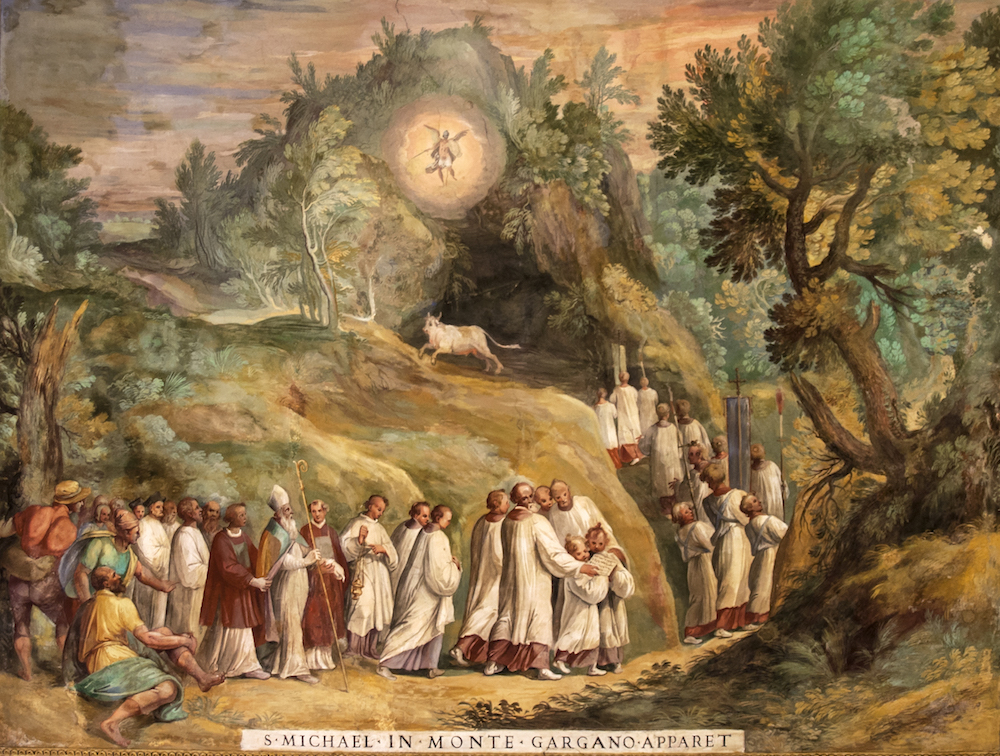Continuing our series on the “Sword of St. Michael,” we will examine one of the most important apparitions of St. Michael along the sacred line of seven monasteries that stretches from Ireland to Israel.
[featured-image single_newwindow=”false”]
This monastery is one of the oldest dedicated to St. Michael. It is named the Sanctuary of Monte Sant’Angelo sul Gargano, or more commonly referred to as, “Monte Gargano.” Located atop a mountain on a peninsula of land surrounded by the Adriatic sea, Monte Gargano is the source of many legendary stories.
According to the Golden Legend, St. Michael the Archangel appeared near a city called Sipontus in 490. A rich man lived there and had sheep and cattle that were grazing about the mountains.
[I]t happened that one bull separated himself from the rest and climbed to the top of the mountain. When the herd came in and this bull’s absence was discovered, the landowner mustered a band of his people to track it up the mountain trails, and they finally found the animal standing in the mouth of a cave at the top. The owner, annoyed at the bull for having wandered off alone, aimed a poisoned arrow at it, but the arrow came back, as if turned about by the wind, and struck the one who had launched it.
He went to the local bishop to tell him of the strange occurrence. He pronounced a three-day fast and for all to ask God for the answer.
They did, and Saint Michael appeared to the bishop and said: “Know that it was by my will that the man was struck by his arrow. I am the archangel Michael, and I have chosen to dwell in that place on earth and to keep it safe. I wished by that sign to indicate that I watch over the place and guard it.”
Later on the local city was under threat of invasion. The bishop again implored the people to pray for three days.
On the third night Michael appeared to the bishop, told him that the prayers had been heard, promised him victory, and ordered that the enemy be met at the fourth hour of daylight. As the battle was joined, Mount Gargano was shaken by a violent earthquake, lightning flashed uninterruptedly, and a dark cloud blanketed the whole peak of the mountain. Six hundred of the enemy troops fell before the swords of the defenders and the fiery lightning flashes. The rest, recognizing the power of the archangel, abandoned the error of idolatry and bent their necks to the yoke of the Christian faith.
St. Michael visited the mountain for a third time in 493, consecrating it as a sacred place, inviting the bishops to lead a procession there.
[T]he bishop of Siponto, together with seven other Apulian bishops went in procession with the people and clergy of Siponto to the holy place. During the procession a wonderful thing happened: some eagles sheltered the bishops from the rays of the sun with their outspread wings. When they arrived at the grotto they found that a primitive altar had already been erected, covered with a vermilion altar cloth and surmounted by a Cross; moreover, according to the legend, they found the footprint of Saint Michael in the rock. With immense joy the holy bishop offered the first divine Sacrifice. It was 29 September. The grotto itself is the only place of worship not consecrated by human hand and over the centuries has received the title of “Celestial Basilica.”
The monastery subsequently became a central point of devotion to St. Michael for many centuries, with pilgrims coming from all over to pay homage to the heavenly archangel.
Here we see St. Michael’s pledge of protection for all those who invoke his intercession and worship the triune God.
After this monastery, there still remain two more monasteries on the sacred line that ends in Israel.

